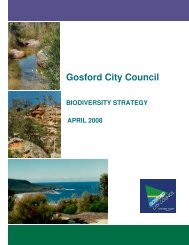Gosford City Council Historical Water Quality Review & Analysis
Gosford City Council Historical Water Quality Review & Analysis
Gosford City Council Historical Water Quality Review & Analysis
Create successful ePaper yourself
Turn your PDF publications into a flip-book with our unique Google optimized e-Paper software.
INTRODUCTION 1-7<br />
The guidelines provide trigger values for freshwater and marine water. The guidelines recommended<br />
moving away from relying solely on chemical guideline values for managing water quality, to using<br />
an integrated approach which would involve chemical-specific guidelines coupled with water quality<br />
monitoring, direct toxicity assessment, and biological monitoring. This approach ensures that water<br />
management will focus on protecting the environment instead of focussing on meeting a number.<br />
The trigger values provided by the ANZECC (2000) guidelines are presented as three grades of<br />
trigger values; high, moderate or low reliability. These grades are dependent on the amount of data<br />
available and hence the confidence or reliability of the final figure. Trigger values have also been<br />
derived for four different protection levels; 99%, 95%, 90% and 80%. The protection level signifies<br />
the percentage of species expected to be protected by monitoring concentrations below the define<br />
values. These values were derived using the statistical distribution method.<br />
1.3.5 Toxicants in Sediment<br />
Sediment are important in aquatic ecosystems as they are a source and sink for dissolved<br />
contaminants, they influence surface water quality, and they are a source of bioavailable<br />
contaminants to benthic biota. Consequently it is important to identify areas were sediments present a<br />
likely threat to ecosystem health. Recommended guideline values are provided as interim sediment<br />
quality guideline (ISQG) values. Guidelines are not specified for some contaminants, which reflects<br />
the absence of an adequate data set for that contaminant. A value for this contaminant can be derived<br />
based on the natural background concentration multiplied by an appropriate factor (a value between 2<br />
and 3 is recommended).<br />
1.3.6 Application<br />
A framework is provided for the application of guidelines for the protection of aquatic ecosystems.<br />
The initial step involves two stages, which are common for the application of all of the indicator types<br />
(biological, physiochemical, chemical and sediment);<br />
1 determine the type of water body, the environmental values, the level of protection required, the<br />
environmental concerns, the factors that are affecting the ecosystem and the management goals;<br />
and<br />
2 select the indicator types depending on the first step and then determining the appropriate trigger<br />
values.<br />
For the remaining steps it is convenient to consider guidelines application separately for biological<br />
indicators and non-biological indicators (physical and chemical stressors and toxicants in water and<br />
sediments). For biological indicators decision trees are used to derive the water quality guidelines.<br />
Non-biological indicators are based on given water quality guidelines, however, there is the option to<br />
refine guidelines using a decision tree. The ANZECC (2000) guidelines detail the method to derive<br />
appropriate guidelines for a specific site, instead of using the trigger values provided within the<br />
guidelines.<br />
D:\R.N0754.002.01.DOC 7/11/03 16:11
















